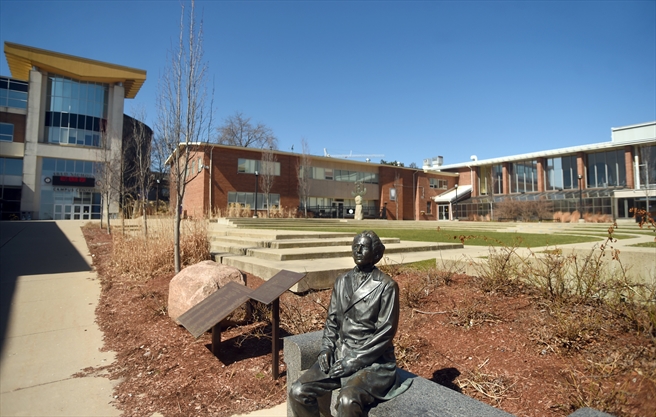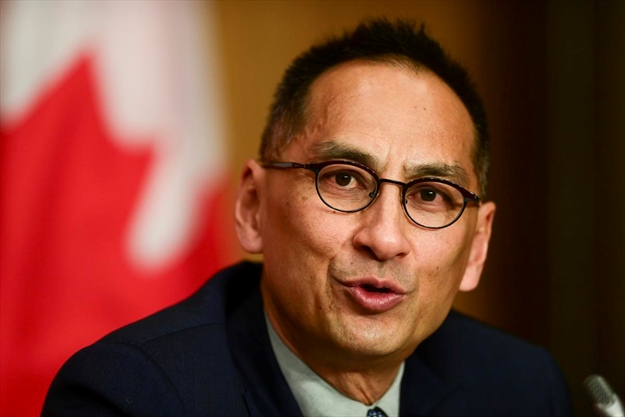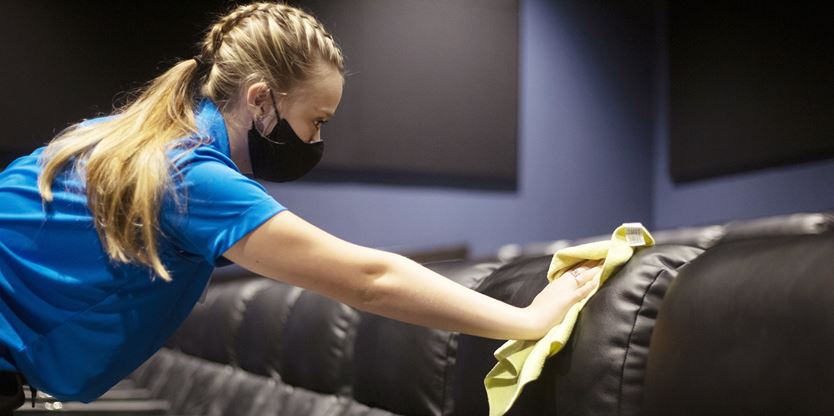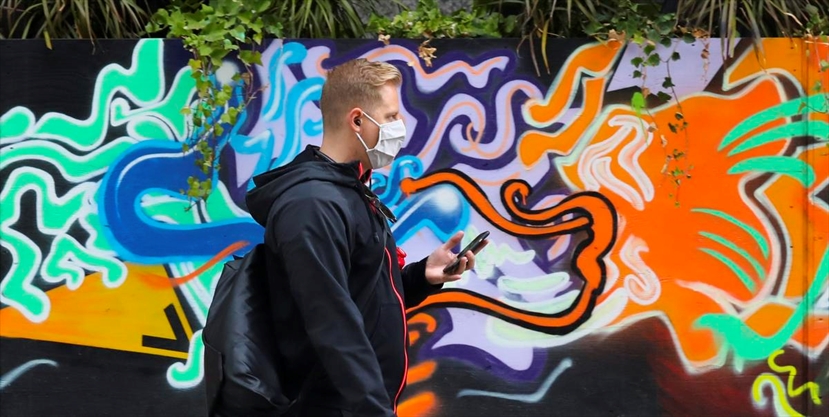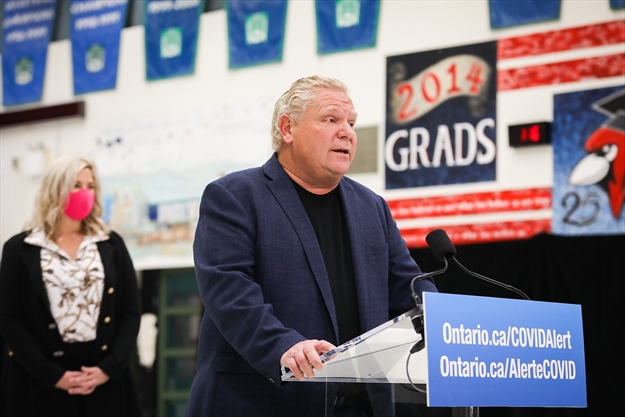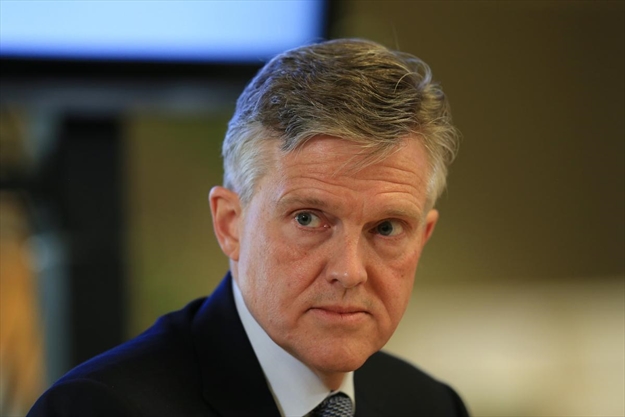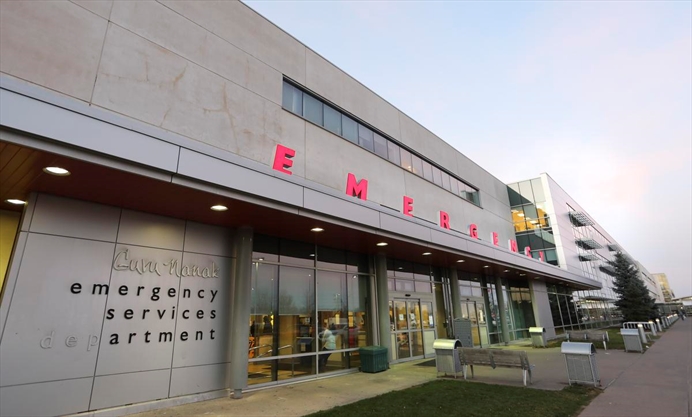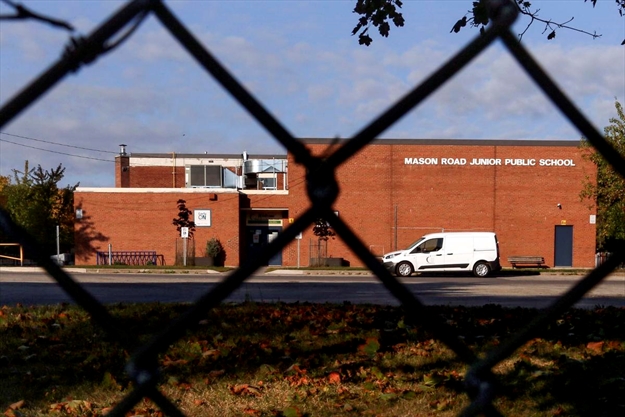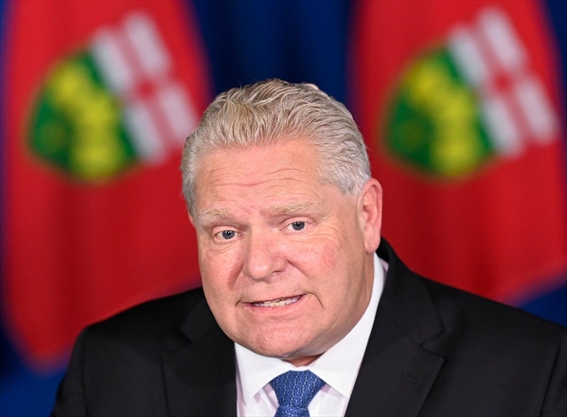The latest news from Canada and around the world Thursday. This file will be updated throughout the day. Web links to longer stories if available.
1:15 a.m.: President Donald Trump and first lady Melania Trump have tested positive for the , the president tweeted early Friday.
Trump’s positive test comes just hours after the White House announced that senior aide Hope Hicks came down with the virus after travelling with the president several times this week. Trump is 74 years old, putting him at higher risk of serious complications from a virus that has now killed more than 200,000 people nationwide.

Trump announced late Thursday that he and first lady Melania Trump were beginning a “quarantine process” after Hicks came down with the virus, though it wasn’t clear what that entailed. It can take days for an infection to be detectable by a test.
Read more here:
11:23 p.m.: U.S. President Donald Trump said Thursday that he and first lady Melania Trump are beginning a “quarantine process” as they await coronavirus test results after a top aide he spent substantial time with this week tested positive for COVID-19.
Trump’s comments came after he confirmed that Hope Hicks, one his closest aides, had tested positive for the virus Thursday. Hicks began feeling mild symptoms during the plane ride home from a rally in Minnesota on Wednesday evening, according to an administration official, who spoke on condition of anonymity to disclose private information. She was quarantined away from others on the plane and her diagnosis was confirmed Thursday, the person said.
Trump tweeted late Thursday: “The First Lady and I are waiting for our test results. In the meantime, we will begin our quarantine process.”
Earlier, during a call-in interview with Fox News Channel’s Sean Hannity, Trump said: “Whether we quarantine or whether we have it, I don’t know. I just went for a test and we’ll see what happens.”
It can take days for an infection to be detectable by a test, and it was unclear what Trump’s quarantine entailed. Minutes before his tweet, the White House distributed a schedule for Friday that showed he planned to go forward with a fundraiser at his Washington, D.C., hotel and a political rally in Sanford, Fla.
Hicks, who serves as counsellor to Trump, also travelled with Trump to the first presidential debate in Cleveland on Tuesday. She is the closest White House official to Trump to test positive for the virus so far.
9:30 p.m.: Hope Hicks, one of U.S. President Donald Trump’s closest aides, has tested positive for the coronavirus.
Hicks, who serves as counsellor to the president and travelled with him to a rally Wednesday, tested positive Thursday, according to an administration official, who spoke on condition of anonymity to discuss private health information. She is the closest aide to Trump to test positive so far.
The White House did not immediately respond to multiple questions about the last time Trump was tested and whether he and other staffers who spent time with Hicks in recent days will be asked to quarantine.
8:19 p.m.: British Columbia’s top doctor says she’s feeling optimistic as the number of COVID-19 cases in the province levels off.
The slowdown comes as B.C. conducted a record 10,899 tests over a 24-hour period in what Dr. Bonnie Henry calls an “incredible feat.”
Of those record tests, 82 people were diagnosed with the virus, a rate Henry said was very low, representing 1 per cent of positive cases.
Henry says that’s an indication that contact tracing is contributing to the levelling off of cases.
One more person has died, bringing the pandemic death toll to 235 people in B.C.
The total number of cases diagnosed in the province is 9,220, while 7,695 people are considered recovered.
7:13 p.m.: Hamilton Public Health has declared a outbreak at KOI Restaurant on Hess Street South after two confirmed cases were linked to the establishment.
HPH is advising anyone who was at the restaurant on Sept. 20 to self-monitor for symptoms.
6:44 p.m.: U.S. President Donald Trump cancelled a planned appearance in western Wisconsin amid calls from the city’s mayor and the state’s governor, both Democrats, that he not hold a rally due to a surge in coronavirus cases.
The director of the La Crosse airport said the event was cancelled due to a lease issue, not concerns over the coronavirus.
Wisconsin ranks third among states for per-capita increases in cases over the past two weeks. State health officials reported 2,887 newly confirmed cases on Thursday, a new daily record, along with 21 more deaths. The state has now seen 125,161 cases and 1,348 deaths since the pandemic began.
Trump replaced the La Crosse rally with one in Janesville, about 280 kilometres away, where the virus is not spreading quite as rapidly. He’s also holding a rally Saturday in Green Bay. Both will be outside at airports. Trump’s decision to visit Janesville prompted authorities there to also request that Trump reconsider.
6:09 p.m.: The RCMP has eased restrictions that sidelined bearded officers, including some Sikh and Muslim members, from front-line policing during the COVID-19 pandemic. Difficulties with properly fitting a mask over religiously mandated facial hair meant some Mounties have been assigned to desk duty in recent months.
That prompted the World Sikh Organization of Canada to press the government to come up with a solution.
The RCMP says affected members across the country may return to operational duties, with a mask, under certain circumstances. Bearded members will be sent out to calls only if the risk of exposure is low or multiple responding officers will be present.
5:53 p.m.: The TDSB says five cases of COVID-19 have been identified in students at Martingrove Collegiate Institute in Etobicoke.
In a letter to parents Thursday, the board said: “It would appear that the five cases are linked to an event that took place in the community on Saturday, September 19th.
“To date, there is no evidence to support the transmission of the virus is connected to the school. However, as a precaution, the students are currently self-isolating and (Toronto Public Health) has reached out to those who may be impacted and has placed two cohorts in self-isolation.”
It wasn’t clear if two previous cases were part of that tally. A total of 447 school-related cases have been reported across the province since school resumed in September, as of Thursday morning.
4:53 p.m.: Nova Scotia will become the latest province to adopt the federal government’s COVID-19 smartphone application, Premier Stephen McNeil confirmed Thursday.
“We’re signing off on it,” McNeil told reporters following a cabinet meeting. “It will be one piece of how we deal with the issue of COVID.” He said the application will available in the near future. Nova Scotia currently has two active cases of COVID-19.
3:21 p.m.: Carnival Cruise Line is cancelling most U.S. sailings through the end of this year, the latest sign that the cruise industry’s recovery from the coronavirus pandemic could still be many months away.
The company said Thursday it is cancelling sailings from all ports except its home ports of Miami and Port Canaveral, Fla. Carnival said it will focus its initial return to operations on those two ports, but it stressed that it still might not sail from those ports in November and December.
2:41 p.m.: Ontario is changing its COVID-19 symptom screening guidance for the province’s schools and child-care centres.
The province is now asking parents to keep their children home from school for 24 hours if they have either a runny nose or headache.
If a child has both of those symptoms they are asked to consult a health-care provider or have a COVID-19 test before returning to school or child care.
Previously, the government had asked that children with either single symptom stay home until they received a negative COVID-19 test or other medical diagnosis.
Ontario is also removing abdominal pain or conjunctivitis from its screening list.
Earlier this month, British Columbia removed 10 symptoms from their school screening sheet including runny nose.
2:32 p.m.: Quebec restaurants and bars forced to close today as part of a partial lockdown to limit the spread of COVID-19 will be eligible for forgivable loans to cover certain fixed costs.
Economy Minister Pierre Fitzgibbon says the loans can cover expenses including municipal taxes, mortgage interest, electricity and rent that are not covered by an existing federal program.
Up to 80 per cent of the amount — to a maximum of $15,000 — will not have to be repaid if conditions are met.
The new, 28-day restrictions also cover indoor and outdoor private gatherings, though Premier Francois Legault and public health director Dr. Horacio Arruda told reporters that Quebecers — and police — will have to use their judgment when it comes to deciding what constitutes an outdoor gathering.
2:24 p.m.: Health Canada has given the green light to a rapid test for coronavirus, but experts say people shouldn’t expect the testing backlog — and lineups — will disappear anytime soon.
“It’s sort of sold as reducing the backlog,” Dr. Zain Chagla, an infectious disease specialist with McMaster University, said about the newly approved ID Now test. “I’m uncomfortable with this. I don’t think this is going to significantly reduce the backlog by any means.
“It is nice to have another tool to get people tested, but this is probably not the test that’s going to change the provincial testing queues altogether.”
2:18 p.m.: Manitoba health officials have announced 36 new COVID-19 cases, 28 of which are in Winnipeg.
The province has also announced the federal government’s COVID Alert app is now up and running in Manitoba, joining other provinces such as Ontario and Saskatchewan.
The smartphone uses Bluetooth technology to detect when users are near each other.
If a user tests positive for COVID-19, they can choose to let other users know about potential exposure risk without sharing any personal information.
2:36 p.m.: The government’s representative in the Senate is promising to introduce tomorrow a motion to hold hybrid sittings of the upper house during the COVID-19 pandemic.
Sen. Marc Gold’s promise clears the way for the Senate to deal swiftly with a bill authorizing new benefits for workers left jobless or underemployed by the health crisis.
Frustration over the Senate’s failure to find a way to resume full operations in the midst of the pandemic prompted some senators Wednesday to block Gold’s attempt to speed Bill C-4 through the chamber.
The bill replaces the now-defunct Canada Emergency Response Benefit with a more expansive employment insurance regime and three new benefits for those who don’t qualify for EI, fall sick or have to stay home to care for a dependent.
It was passed unanimously in the House of Commons in the early hours of Wednesday morning.
The Senate has sat only occasionally and briefly since mid-March to pass emergency aid legislation; many senators want to adopt a format similar to that now being used in the Commons, with members able to participate in all proceedings, including votes, either in person or virtually.
2:05 p.m.: Ontario says it will give pay raises to personal support workers throughout the health-care system in a bid to recruit and retain them during the COVID-19 pandemic.
Premier Doug Ford says about 147,000 workers in long-term care, hospitals, and community care are eligible for the increase.
Personal support workers in long-term care and community care will be eligible for a $3 an hour pay increase, while hospital PSWs will see a $2 an hour pay hike.
The temporary increase will cost the government $461 million, begins today and will expire in March 2021.
Ford says he has not ruled out continuing the pay raise next year.
Advocates in the long-term care and home care sectors have said low pay has contributed to PSW shortages before and during the pandemic.
2 p.m.: A group of homeless people living in Toronto encampments are telling a court it’s safer to live in tents than be forced to stay in shelters or hotels far away from services during the COVID-19 pandemic.
The group, which includes 14 people living in encampments as well as activists, is seeking an interim order allowing homeless individuals to stay in city parks until a constitutional challenge of a bylaw is heard.
The bylaw bans living or camping in parks after midnight.
The group says the city’s threats to remove them from parks violates their charter rights, and says the city’s attempts to clear the camps is cruel.
The city argues that the Charter of Rights and Freedoms does not entitle members of the group to live in parks.
It says it has worked hard to make shelters safer during the pandemic and has found temporary or permanent homes for hundreds living in encampments.
Since the pandemic began, hundreds of people have fled shelters out of fear of contracting COVID-19 and have been living outside.
There have been 649 cases of COVID-19 in the city’s shelter system and five deaths.
1:54 p.m.: New York Gov. Cuomo unveiled a new smartphone app on Thursday that alerts users if they’ve been within 6 feet of a person who has tested positive for the virus.
The app, called “COVID Alert NY,” employs Bluetooth technology to record whenever users come within proximity of each other, though Cuomo cautioned on a conference call with reporters that it’s anonymous and collects no personal or geographic data.
“It doesn’t give any names, doesn’t give any privacy information,” the governor said.
The technology only works if a person who tests positive downloads the app and registers the COVID-19 diagnosis.
In turn, the app retroactively alerts other users who have recently been within 6 feet of the infected person for more than 10 minutes.
“It’s voluntary,” Cuomo said. “You have to download the app, but it’s a great tool that alerts you if you happen to be within 6 feet of a person who tests positive.”
He added, “It’s going to give people comfort.”
1:52 p.m.: About 2,000 Honduran migrants hoping to reach the United States entered Guatemala on foot Thursday morning, testing the newly reopened frontier that had been shut by the coronavirus pandemic.
Authorities had planned to register the migrants as they crossed and offer assistance to those willing to turn back, but the group crossed the official border at Corinto without registering, according to Guatemala immigration authorities. Outnumbered officials made no attempt to stop them.
Before the crossing happened, Edwin Omar Molino, a 17-year-old from Cortes, said he wanted to leave Honduras because he couldn’t find work. He blamed President Juan Orlando Hernández for running the country into the ground.
“Even when you want to find a job, there aren’t any. That’s why we leave our country,” Molino said.
“There’s the pandemic, and it scares me,” he added. But he said he wouldn’t be able to help his family get ahead without taking the risk.
Central American migrants began travelling in large groups in recent years, seeking safety in numbers and in some cases avoiding the cost of smugglers. Calls for a new migrant caravan to leave Oct. 1 had circulated for weeks on social media.
1:25 p.m. Canadian chef Susur Lee’s Lee Restaurant has closed after an employee contracted COVID-19.
The restaurant announced its temporarily closing Thursday afternoon in to customers.
The employee’s last shift was on Sept. 23 and they have been self-isolating since.
“We have decided to focus on takeout and delivery in consideration of our staff and guests safety and well-being,” the notice said.
1:15 p.m. Labour leaders are calling on Ottawa to provide immediate financial aid and rapid viral testing to an airline industry devastated by the COVID-19 pandemic.
The heads of two pilots’ unions and Unifor asked the federal government on Thursday to offer carriers loans totalling $7 billion.
“The COVID-19 pandemic has created a crisis in Canada’s aviation industry unlike anything seen before, and recovery may be years away,” said Tim Perry, head of the Air Line Pilots Association’s Canadian branch.
The 10-year credit plan being requested would include loan guarantees and direct financial aid but no grants, and would be commensurate with the support extended by other countries, they said.
The unions also asked Ottawa to back approval and deployment of rapid COVID-19 tests for passengers as a step toward easing travel restrictions and quarantine rules.
1:08 p.m. The Ontario government says it will give 147,000 eligible personal support workers a “much deserved pay raise.” It’s $3 per hour extra for most personal support workers, $2 more per hour for PSWs in hospitals. This is until March 2021.
12:40 p.m. Ottawa is in negotiations with all remaining provinces that have not yet adopted the national COVID Alert app.
Manitoba is live Thursday, and Quebec is to follow in the next few days.
Marika Nadeau, with the COVID Alert task force, says British Columbia, Alberta, Nova Scotia, and Prince Edward Island are in the final stages of discussions as well.
Nadeau says as of today, 610 people who have tested positive for COVID-19 used the app to alert close contacts.
Most of those were in Ontario, but a few were in Saskatchewan.
That is less than five per cent of positive cases in Ontario since the app went live at the end of July, but Nadeau says every time the app is used is helpful to slowing the spread of COVID-19.
12:07 p.m. Quebec is reporting 16 new deaths attributed to the novel coronavirus as its two biggest cities enter a partial lockdown.
Health officials said today two deaths occurred in the past 24 hours, 12 occurred between Sept. 24-29 and two took place before Sept. 24.
Quebec has reported a total of 5,850 deaths linked to the virus.
The province reported 933 new COVID-19 infections Thursday, for a total of 75,221 cases since the beginning of the pandemic.
Hospitalizations increased by 13 compared with the prior day, for a total of 275, with 46 people in intensive case, a rise of three patients.
Starting Thursday, indoor and outdoor gatherings are banned across Montreal and Quebec City, while bars and other venues in those cities are closed, as the government tries to limit the spread of COVID-19.
12:03 p.m. A worker at a Brampton Fortinos grocery store recently tested positive for COVID-19.
According to the COVID-19 tracker from parent company, Loblaws, the employee works at the and tested positive on a presumptive test.
Management was notified of the case on Sept. 30 and the employee’s last day of work was Sept. 21.
As with every positive case, each location goes through a deep clean and sanitization.
Two other employees at Loblaws-owned stores in Brampton have recently tested positive for COVID-19 as well.
On Sept. 29 a case was identified at the Mountainash Road Shoppers Drug Mart and on Sept. 26 a case was identified at the Real Canadian Superstore on Steeles Avenue.
10:52 a.m. Madrid and its suburbs prepared Thursday to enter a soft lockdown that restricts trips and out of the Spanish capital following a weeks-long political turf fight that experts say has prevented an effective response to the coronavirus in Europe’s latest infection hot spot.
Regional President Isabel Díaz Ayuso said she would implement new national health regulations that impose restrictions on movement and business and social activity in large Spanish cities with high infection rates while Madrid also mounts a legal challenge to the national government order requiring the measures.
The Spanish Health Ministry’s new standards give the country’s 19 regions two days to cap social gatherings to a maximum of six people and limit shop and restaurant hours in large cities that have recorded a 2-week infection rate of 500 cases per 100,000 residents or above. The regulations also mandate restrictions on entering and leaving such cities.
10:37 a.m. (updated) Another 538 Ontario residents have contracted COVID-19 as the backlog of tests in labs grew to 82,473 — double the daily capacity of the processing system — leading to further delays in getting results to people.
The new infections reported Thursday were down from 625 on Wednesday, when health officials warned the increasingly rapid spread of the virus because of lax pandemic precautions is propelling the province toward 1,000 new cases daily in early October, with the number of infections doubling every 10 to 12 days.
There were three new deaths for a total of 11 since Monday, according to the report from the Ministry of Health.
Two statistics suggested the virus is broadening its grip. The percentage of people under 40 testing positive has decreased to 60 per cent, meaning cases are increasing in older age groups more likely to need medical care. As well, 10 of the province’s 34 public health units reported no new cases, down from about 18 daily through most of the summer.
10:18 a.m. The NFL postponed Sunday’s Pittsburgh Steelers game at Tennessee until later in the season after one additional Titans player and one personnel member tested positive for COVID-19.
The announcement Thursday came one day after the league said it hoped to play the game on Monday or Tuesday. The NFL said a new game date would be announced “shortly.”
“The decision to postpone the game was made to ensure the health and safety of players, coaches and game day personnel,” the league said. “The Titans facility will remain closed and the team will continue to have no in-person activities until further notice.”
On Tuesday, the Titans (3-0) placed three players on the reserve/COVID-19 list, including key players defensive captain and lineman DaQuan Jones and long snapper Beau Brinkley. Outside linebacker Kamalei Correa became the fourth on that list Wednesday.
With the two new cases, the Titans’ total is now 11: five players and six other organization members. That doesn’t include outside linebackers coach Shane Bowen whose positive result came back last Saturday, preventing him from travelling with Tennessee to Minnesota for a 31-30 win.
10:07 a.m. South Africa has reopened to international flights, ending a more than six-month ban on international travel that was part of its restrictions to combat the spread of COVID-19.
A Lufthansa plane from Germany was the first international flight to arrive Thursday morning at Johannesburg’s O.R. Tambo International Airport. Flights from Kenya, Zambia, and Zimbabwe quickly followed. Airports in Cape Town and Durban have also resumed international traffic.
Travellers arriving on international flights must provide a negative COVID-19 test issued no more than 72 hours before their departure.
South Africa still maintains restrictions on international travel. Tourists are not permitted from a list of more than 50 countries, including Russia, Britain and the U.S, which are deemed high risk because of their levels of COVID-19 cases. The list will be reviewed every two weeks.
Travellers must also have proof of travel insurance to cover a COVID-19 test and quarantine costs, should they have symptoms during their visit.
9:40 a.m. Unemployment rose for a fifth straight month in Europe in August and is expected to grow further amid concern that extensive government support programs won’t be able keep many businesses hit by coronavirus restrictions afloat forever.
The jobless rate increased to 8.1 per cent in the 19 countries that use the euro currency, from 8 per cent in July, official statistics showed Thursday. The number of people out of work rose by 251,000 during the month to 13.2 million.
While Europe’s unemployment rate is still modest compared with the spike seen in many other countries, economists predict it could hit double digits in coming months as wage support programs expire. A resurgence in infections in many countries has meanwhile led to new restrictions on businesses and public life may that may have to be broadened and could lead to more layoffs.
European governments have approved trillions of euros to help businesses, setting up or bolstering programs to keep workers on payrolls.
9:13 a.m. Managing through this next phase of the pandemic, when the adrenalin of the initial crisis has long worn off and there’s no finish line yet in sight, is going to take a new level of adjustment for.
We’ve hit what Aisha Ahmad, a University of Toronto associate professor of international security described as “the six-month wall” — just as we levelled up the uncertainty of COVID-19 living with our kids returning to school.
Drawing on experience living in disaster zones while conducting field research in places such as Afghanistan and Somalia, Ahmad defined the six-month wall as a slump she inevitably hit when her desire to escape or “make it stop” was overwhelming. Inevitably, however, it passes after a few weeks, she explained. The key is to be gentle with ourselves while we do some resetting that will get us through the months ahead.
“Just don’t expect to be sparklingly happy or wildly creative in the middle of your wall,” she wrote. “Right now, if you can meet your obligations and be kind to your loved ones, you get an A-plus.”
9:02 a.m. On his first day of school this month, nine-year-old Lionel was nervous and excited — a combination as old as time when September rolls around. Excited, because he wanted to know who his teacher would be for the fourth grade. But his nerves weren’t about new classmates, harder lessons or other typical adjustments to .
“I felt nervous because I didn’t want to get COVID-19,” Lionel wrote in a journal entry during his first week back to class. He described, on the page, the things that had changed since last year. “We have to wear masks, some of my friends left and when we go to the classroom we can’t go straight to our chair, we have to go in a circle wash my hands and then go to our seat.”
The main target of his ire was wearing a mask during school hours, evident in all capital letters: “I DO NOT LIKE IT AT ALL!!!”
But other frustrations showed through, too: “I have a hard time social distancing because I want to play with my friends.”
Lionel is one of more than a thousand children living in Toronto’s shelter system during the pandemic. Following a , where families and kids in shelters revealed their struggles keeping up with online learning this spring, the Star invited Lionel and several other kids living in shelters to keep journals of their first week back to class.
8:48 a.m. The Italian league soccer match between Genoa and Torino on Saturday has been postponed because 15 players and staff at Genoa tested positive for the coronavirus. Local health authorities in Genoa have banned the team from training. The league did not immediately set a new date for the game.
Genoa already had last weekend’s game at Napoli postponed for several hours while players awaited test results.
8:46 a.m. Turkey stopped announcing all of its coronavirus cases months ago and has instead been disclosing only the number of “patients” who test positive and show symptoms.
Health Minister Fahrettin Koca acknowledged the change on Wednesday, as he responded to an opposition lawmaker’s claims that the government has been vastly understating the number of COVID-19 infections. His remarks outraged medical groups who have accused the government of fueling the country’s outbreak.
The decision to stop counting people who are infected but don’t need treatment was made because of the high number of asymptomatic cases detected by widespread testing, according a person with direct knowledge of the matter. It was made shortly before the ministry on July 29 tweaked the wording in its COVID-19 updates to report new “patient” numbers instead of new “cases,” the person said.
8:40 a.m. Russian health officials reported nearly 9,000 new coronavirus cases on Thursday, one of the largest increases in months.
The 8,945 cases are almost twice as many as health officials were registering in late August. The new cases brought the country’s total to more 1.18 million, fourth highest in the world. There have been 20,796 confirmed deaths — 12th highest globally — according to a tally by Johns Hopkins University.
Despite the increases, authorities have repeatedly dismissed a second lockdown or other major restrictions. However, Moscow officials last week asked the elderly to stay at home, and employers to allow people to work from home. The mayor of Moscow also extended school holidays that start Oct. 5 to two weeks.
Russian President Vladimir Putin on Monday urged Russians to remain vigilant.
8:39 a.m. Elora’s annual Monster March Halloween parade has been cancelled, but the downtown monster displays are still going up and other events are moving forward.
Kirk McElwain, chair of Sensational Elora who own and manage the displays, confirmed the Monster March parade is cancelled and are trying to develop an alternative virtual event but nothing is finalized yet.
However, Tim Murton’s Twilight Zoo sculptures are still going up and McElwain said it will be a bigger and better display than usual.
“We normally charge local businesses for putting up the monster on their building,” McElwain said, explaining that it covers storage and repairs.
“This year we’re doing it all for free just as a thank you to the businesses because of COVID and how it may have affected some businesses.”
This resulted in many businesses willing to go ahead with having the displays on their building or property.
All of October would normally be packed with events in Centre Wellington for Monster Month but many have also been cancelled this year.
8:31 a.m. India on Thursday reported 86,821 new coronaviruses cases and another 1,181 fatalities, making September its worst month of the pandemic.
The Health Ministry’s update for the past 24 hours raised India’s total to more than 6.3 million people infected and 98,678 dead from COVID-19. India added 41 per cent of its confirmed cases and 34 per cent of fatalities in September alone.
India is expected to become the pandemic’s worst-hit country within weeks, surpassing the United States, where more than 7.2 million people have been infected.
The government announced further easing of restrictions to start Oct. 15. Cinemas, theatres and multiplexes can open with up to 50 per cent of seating capacity, and swimming pools can also be used by athletes in training.
The government also said India’s 28 states can decide on reopening of schools and coaching institutions gradually after Oct. 15. However, the students will have the option of attending online classes.
International commercial flights will remain suspended until Oct. 31. However, evacuation flights will continue to and from the United States, Britain, Australia, Canada, France, Japan and several other countries.
8:14 a.m. Health Canada has given the green light to a rapid test for , but experts say people shouldn’t expect the testing backlog — and lineups — will disappear anytime soon.
“It’s sort of sold as reducing the backlog,” Dr. Zain Chagla, an infectious disease specialist with McMaster University, said about the newly approved ID Now test. “I’m uncomfortable with this. I don’t think this is going to significantly reduce the backlog by any means.
“It is nice to have another tool to get people tested, but this is probably not the test that’s going to change the provincial testing queues altogether.”
Ottawa announced Wednesday it approved the test developed by Abbott Laboratories, which can deliver results in less than 15 minutes of a patient being swabbed, without having to first send the sample to a lab for processing.
8:03 a.m. The Canadian economy faces a long, slow recovery from , and some industries are never bouncing back to where they were, according to a new forecast from a business think tank.
The prediction, from the Conference Board of Canada, says things won’t get back to anywhere close to normal until there’s to battle COVID-19, likely sometime next June.
“Until we’re seeing COVID fully behind us, it’s going to be a rough ride. We won’t see a complete recovery until there’s a vaccine and this has been brought under control. The biggest risk is if a vaccine ultimately isn’t found,” said Conference Board chief economist Pedro Antunes in an interview.
8:02 a.m. Touted as one of the only things that could finally bring the pandemic to heel, anticipation for a COVID-19 vaccine is building.
But while Canadians wait, thousands of drug company employees, government officials and front-line workers in China are reportedly already rolling up their sleeves.
To back up a step, or 10, there are serious questions about the safety of those vaccines and the willingness of the test subjects. But with several Chinese companies claiming their vaccines could clear clinical testing as early as the question is being asked. Could China win the vaccination race and, if so, what does that mean for Canada and the rest of the world?
8 a.m. In what’s being called a “shocking” misuse of personal health information, Ontario police services made unauthorized searches of the province’s first-responder data portal — including querying entire postal codes to find active cases of the virus, according to documents obtained by two civil rights groups.
In a memo addressed to all police chiefs in June, Ontario’s Ministry of the Solicitor General said an audit of the COVID-19 database — a and now-shuttered portal for first responders — revealed “many” searches violating the province’s directive that the tool be used cautiously and with precision.
The audit raised “concerns that the portal is being used beyond the express purpose that the government intends,” wrote Richard Stubbings, assistant deputy minister of the public safety division, in a June 11 letter.
Among the unauthorized searches listed: “broad-based” municipal searches with no specific address, including queries of postal codes or of another municipality, and searches of a specific name unrelated to an active call for service.
7 a.m. The U.S. government will provide its latest picture Thursday of the pace of layoffs which have remained high as some sectors of the economy have rebounded since the viral pandemic erupted in March while others remain depressed.
The still-elevated number of people seeking unemployment benefits each week reflects an economy that has recovered only about half the 22 million jobs that were lost to the pandemic. Many employers, especially small retailers, hotels, restaurants, airlines and entertainment venues, are still struggling. And millions of Americans are facing unemployment with vastly diminished aid since the expiration of a $600-a-week federal benefit this summer.
At the same time, some newly laid-off people are facing delays in receiving unemployment benefits as some state agencies intensify efforts to combat fraudulent applications and clear out backlogged claims. California, the largest state, has stopped processing new applications for two weeks as it seeks to reduce backlogs and pursue suspected fraud.
6:31 a.m.: The U.S. government will provide its latest picture Thursday of the pace of layoffs in the country, which have remained high as some sectors of the economy have rebounded since the viral pandemic erupted in March while others remain depressed.
The still-elevated number of people seeking unemployment benefits each week reflects an economy that has recovered only about half the 22 million jobs that were lost to the pandemic. Many employers, especially small retailers, hotels, restaurants, airlines and entertainment venues, are still struggling. And millions of Americans are facing unemployment with vastly diminished aid since the expiration of a $600-a-week federal benefit this summer.
At the same time, some newly laid-off people are facing delays in receiving unemployment benefits as some state agencies intensify efforts to combat fraudulent applications and clear out backlogged claims. California, the largest state, has stopped processing new applications for two weeks as it seeks to reduce backlogs and pursue suspected fraud.
5:25 a.m.: The Israeli government has approved a measure to limit protests and worship to within a kilometre (mile) of a person’s home, a controversial step to curb the spread of the coronavirus that critics say is aimed at quashing weekly protests against Prime Minister Benjamin Netanyahu.
The Cabinet also approved late Wednesday a three-day extension of the country’s nationwide lockdown, imposed Sept. 18, until Oct. 14.
Defence Minister Benny Gantz defended the protest measure in an interview with Israel Radio, saying that at the moment there was “a need for a postponement” in the demonstrations to halt the spread of the disease. He said the lockdown would likely remain for several more weeks.
Israel has seen a major increase in the number of new confirmed COVID-19 cases in recent weeks, and reached a new daily high of nearly 9,000 on Thursday.
5:23 a.m.: Rolls-Royce Holdings plans to raise 2 billion pounds ($2.6 billion) by selling shares to existing investors after airlines around the world cut flights in response to the COVID-19 pandemic, slashing revenue for the jet-engine maker.
The London-based company said Thursday it also plans to raise at least 1 billion pounds by selling bonds, and it may increase borrowing by up to 2 billion pounds.
The financing package comes after the company earlier this year announced plans to cut at least 9,000 jobs and reduce costs by up to 1.3 billion pounds by the end of 2022. About 4,800 people had left the company by the end of August.
Chief Executive Warren East says, “the capital raise announced today improves our resilience to navigate the current uncertain operating environment.”
5:19 a.m.: Singapore will allow entry to travellers from Vietnam and Australia, excluding its coronavirus hot spot Victoria state, from Oct. 8.
The tiny city-state last month welcomed visitors from Brunei and New Zealand, and is cautiously reopening its borders after a virus closure to help revive its airport, a key regional aviation hub. The aviation authority has said there is a low risk of virus importation from the two countries.
Travellers must undergo a virus swab test upon arrival, travel on direct flights without transit and download a mobile app for contact tracing. Singapore’s move is not reciprocated by the other four countries.
5:14 a.m.: India on Thursday reported 86,821 new coronaviruses cases and another 1,181 fatalities, making September its worst month of the pandemic.
The Health Ministry’s update for the past 24 hours raised India’s total to more than 6.3 million people infected and 98,678 dead from COVID-19. India added 41% of its confirmed cases and 34% of fatalities in September alone.
India is expected to become the pandemic’s worst-hit country within weeks, surpassing the United States, where more than 7.2 million people have been infected.
The government announced further easing of restrictions to start Oct. 15. Cinemas, theatres and multiplexes can open with up to 50% of seating capacity, and swimming pools can also be used by athletes in training.
The government also said India’s 28 states can decide on reopening of schools and coaching institutions gradually after Oct. 15. However, the students will have the option of attending online classes.
5:07 a.m.: Three Quebec regions face partial lockdown measures starting today after reaching the highest COVID-19 alert level earlier this week.
People living in the greater Montreal, Quebec City and Chaudiere-Appalaches region south of the provincial capital will live with the new restrictions for at least 28 days as the province tries to get COVID-19 cases under control.
Bars, casinos, concert halls, cinemas, museums and libraries are to be shuttered in those regions and restaurants will be limited to takeout.
Private gatherings are prohibited and people cannot have any visitors from another address at their homes with few exceptions, like caregivers or maintenance workers.
Outdoor gatherings are forbidden, masks are mandatory for demonstrations and police have the power to hand out hefty fines to those who flout the rules.
5:03 a.m.: Four major home-care providers are asking the Ontario government to increase support for their sector, saying it would reduce pressure on a health-care system burdened by COVID-19.
The companies — Bayshore HealthCare, Closing the Gap Healthcare, VON Canada, and SE Health — say bolstering home care will allow long-term care homes and hospitals to operate more efficiently.
The group has launched a campaign today on their call for support.
The CEO of Closing the Gap Healthcare says COVID-19 transmission rates in home-care settings are much lower than in congregate care.
Leighton McDonald says by focusing on community-care, the province can help keep more people safe from the virus.
According to provincial data through the height of the first wave of COVID-19 until the end of May, there were 235 virus cases related to home care, compared to 4,518 in long-term care homes.
5 a.m.: Vaccines normally offered in school to Grade 7 students will instead be delivered at community clinics and doctors’ offices in parts of Ontario, meaning parents will have to make arrangements to ensure their children are immunized.
The Ministry of Health says local public health units, which are responsible for immunization programs including those in schools, are working to let residents know where they can access the vaccines.
Students in Grade 7 are typically given vaccines for Hepatitis B, Human Papilloma Virus and Meningococcal disease in school. Some of those shots require more than one dose.
Those programs have been disrupted due to COVID-19, which has seen thousands of students choose virtual lessons over in-person classes.
In Ottawa and Toronto — two regions experiencing a surge in COVID-19 cases — public health officials say clinics will prioritize administering the flu vaccine this fall.
But they say vaccination clinics for students will be held in the community at a later date to replace the in-school programs.
4 a.m.: Nearly half of students at public elementary schools in a COVID-19 hot spot west of Toronto are learning online, according to data provided by the school board.
Upwards of 54,600 elementary students have opted for remote learning this year at the Peel District School Board and 57,300 have returned to the classroom.
That compares to roughly 35 per cent of elementary students who are learning online at the Toronto District School Board — the province’s largest.
Meanwhile, the Peel board’s high schools are running on an adapted model, with students who chose in-class learning only attending school half the time to minimize contact with their peers.
Still, the board says 27 per cent of high schoolers — around 11,200 — are learning fully online.
Peel Public Health says it’s seen 9,707 cases of COVID-19 throughout the pandemic, 8,396 of whom have recovered, and 329 deaths.
Wednesday 10:06 p.m.: Fans can take themselves out to the ball game for the first time this season during the National League Championship Series and World Series at new Globe Life Field in Arlington, Texas.
Major League Baseball said Wednesday that approximately 11,500 tickets will be available for each game. That is about 28 per cent of the 40,518-capacity, retractable-roof stadium of the Texas Rangers, which opened this year adjacent to old Globe Life Park, the team’s open-air home from 1994 through 2019.
“Any time there’s fans in the stands there’s maybe a heightened sense of, this is a real game and it might raise everybody’s play,” said Los Angeles Dodgers pitcher Clayton Kershaw, who lives in the Dallas area during the off-season.
The World Series is being played at a neutral site for the first time in response to the coronavirus pandemic. It has not been played at one stadium since the St. Louis Cardinals defeated the Browns at Sportsman’s Park in 1944.
While Texas is allowing up to 50 per cent capacity at venues, MLB did not anticipate having government permission for fans to attend post-season games at Dodger Stadium in Los Angeles or Petco Park in San Diego, where American League playoff games are scheduled.

